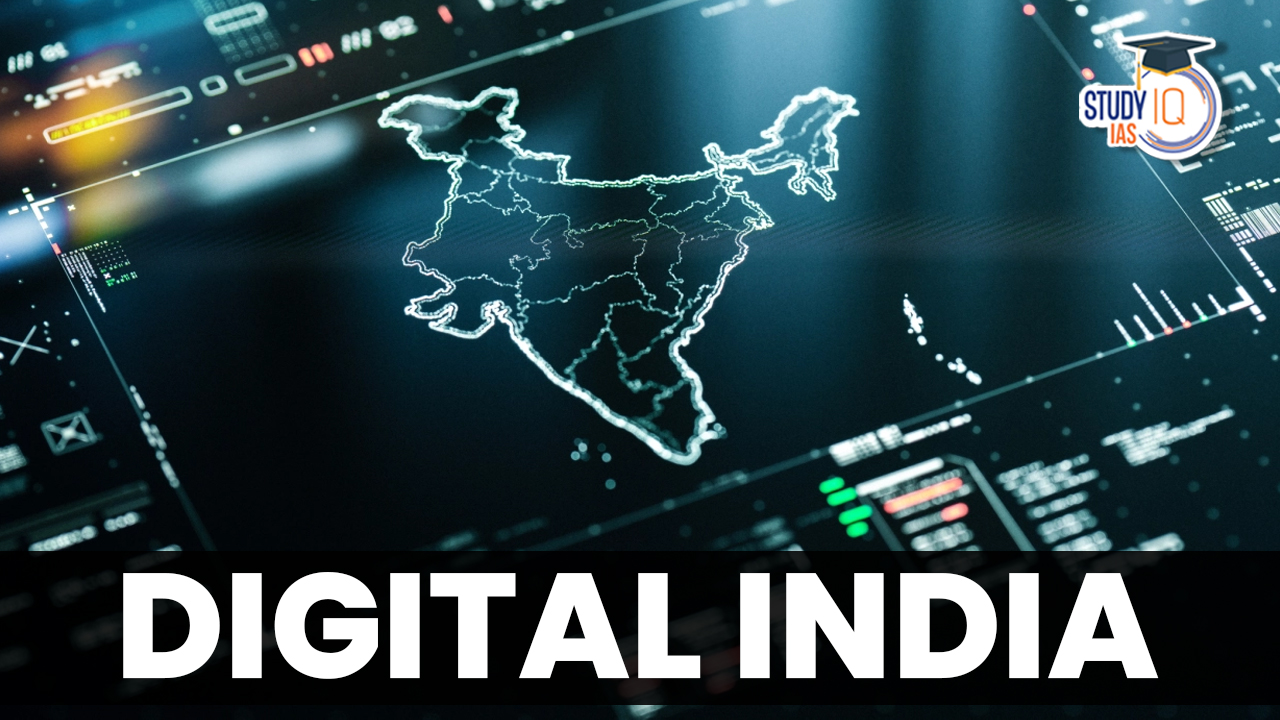Table of Contents
Digital India Mission
The Digital India Mission, launched by Prime Minister Narendra Modi on July 1, 2015, aims to transform India into a digitally empowered society and knowledge economy. The mission seeks to make government services accessible to citizens electronically by improving online infrastructure and enhancing internet connectivity.
What is Digital India Programme?
Digital India Mission is sometimes also referred to as Digital India Programme which was launched in July 2015 by Prime Minister Narendra Modi. Digital India Programme envisions comprehensive digital infrastructure, increased digital literacy, and widespread digital access across all sectors, from governance and education to health and financial services. The Digital India initiative seeks to bridge the digital divide, promote digital inclusion, and leverage technology to enhance the quality of life for all citizens while promoting economic growth and innovation.
The Digital India Initiative holds the potential to reshape the very fabric of our nation, fostering innovation, connectivity, and empowerment across every stratum of society. In this article, you will get all about Digital India Mission, its pillars, vision, impact, advantages and challenges in detail for your exam preparation.
Digital India for New India
Digital India for New India is a vision to create a new India where all citizens have access to the benefits of digital technology. This includes access to education, healthcare, financial services, and government services. It also includes the ability to participate in the digital economy and to create new opportunities for oneself. Digital India for New India is being driven by many initiatives, including:
- BharatNet
- Digital Literacy Mission
- e-Governance
- Startups and Innovation etc.
9 Pillars of Digital India Initiative
The Digital India Initiative is built upon 9 key pillars, each focusing on transforming India into a digitally empowered nation. Here we discussed the 9 Pillars of Digital India Initiative in detail.
| Pillar | Key Components/Goals |
|---|---|
| Broadband Highways |
|
| Universal Access to Mobile Connectivity | Cover 42,300 uncovered villages with mobile connectivity |
| Public Internet Access Programme |
|
| e-Governance |
|
| e-Kranti | Deliver services electronically across education, health, agriculture, security, financial inclusion, justice, planning, and cybersecurity |
| Information for All |
|
| Electronics Manufacturing | Achieve net zero imports through incentives, economies of scale, skill development, and focus on key electronic products |
| IT for Jobs |
|
| Early Harvest Programmes | Implement short-term impactful projects like mass messaging, e-greetings, biometric attendance, Wi-Fi in universities, secure email, public Wi-Fi hotspots, and eBooks for schools |
- Broadband Highways:
- Broadband for All – Rural: Connecting 250,000 village Panchayats by deploying high-speed internet infrastructure.
- Broadband for All – Urban: Utilizing Virtual Network Operators for service delivery and ensuring robust communication infrastructure in new urban developments.
- National Information Infrastructure (NII): Integrating networks like SWAN, NKN, and NOFN along with cloud-enabled data centers to ensure horizontal connectivity across various levels of government offices.
- Universal Access to Mobile Connectivity:
- Extending mobile connectivity to 42,300 uncovered villages, focusing on network penetration and addressing connectivity gaps across the country.
- Public Internet Access Programme:
- Common Service Centres (CSCs): Expanding the number of CSCs from 135,000 to 250,000, making them multi-functional endpoints for delivering government and business services.
- Post Offices as Multi-Service Centres: Converting 150,000 Post Offices into multi-service centers to provide various digital services.
- e-Governance: Reforming Government through Technology:
- Simplifying government processes through IT to make them more efficient and transparent.
- Promoting online applications, tracking, and interdepartmental interfaces.
- Mandating the use of online repositories for documents to reduce physical submission requirements.
- Integrating services and platforms like UIDAI, Payment Gateway, Mobile Platform, and EDI for seamless service delivery.
- e-Kranti – Electronic Delivery of Services:
- Technology for Education: Connecting schools with broadband, providing free Wi-Fi, and promoting digital literacy.
- Technology for Health: Facilitating online medical consultations, records, and medicine supply.
- Technology for Farmers: Providing real-time price information, online ordering, and mobile banking for farmers.
- Technology for Security: Offering mobile-based emergency services and disaster-related information.
- Technology for Financial Inclusion: Enhancing mobile banking, Micro-ATM programs, and using CSCs/Post Offices for financial services.
- Technology for Justice: Strengthening systems like e-Courts, e-Police, e-Jails, and e-Prosecution.
- Technology for Planning: Implementing National GIS for decision-making in project planning and development.
- Technology for Cyber Security: Establishing a National Cyber Security Coordination Center.
- Information for All:
- Promoting open access to government data and documents through online platforms.
- Engaging citizens via social media and web-based platforms for two-way communication.
- Utilizing existing infrastructure for disseminating information with minimal additional resources.
- Electronics Manufacturing:
- Aiming for net zero imports by promoting electronics manufacturing through taxation incentives, economies of scale, and skill development.
- Focus areas include FABS, fab-less design, set-top boxes, VSATs, mobiles, consumer & medical electronics, smart energy meters, and smart cards.
- Strengthening existing structures and creating new programs to achieve manufacturing goals.
- IT for Jobs:
- Training 1 crore students from smaller towns and villages for IT sector jobs over 5 years.
- Setting up BPOs in northeastern states for ICT-enabled growth.
- Training 3 lakh service delivery agents for running IT service businesses.
- Training 5 lakh rural workforce by Telecom Service Providers to meet their own needs.
- Early Harvest Programmes:
- Implementing short-term projects with immediate impact, such as:
- Mass Messaging Application: Covering elected representatives and government employees.
- Government e-Greetings: Providing templates for electronic greetings.
- Biometric Attendance: Covering all Central Government offices in Delhi.
- Wi-Fi in Universities: Covering all universities on the National Knowledge Network.
- Secure Email: Upgrading secure email infrastructure for government employees.
- Public Wi-Fi Hotspots: Establishing hotspots in cities with populations over 1 million and tourist centers.
- eBooks for Schools: Converting all school books to eBooks.
- SMS-based Weather Information and Disaster Alerts: Providing real-time information via SMS.
- National Portal for Lost & Found Children: Facilitating real-time information sharing to improve response times for lost and found children.
- Implementing short-term projects with immediate impact, such as:
Vision of Digital India Mission
The Digital India Mission envisions a comprehensive transformation of India into a digitally empowered society and knowledge economy. This ambitious program, launched by the Indian government, seeks to leverage the power of technology to bridge the gap between urban and rural communities, enhance government services, and drive economic growth.
Digital Infrastructure
One of the primary visions of the Digital India initiative is to establish a robust and inclusive digital infrastructure. This includes the expansion of high-speed internet connectivity to every corner of the country, ensuring that even remote areas have access to the digital world. By bridging the digital divide, the initiative aims to promote equitable access to information, education, and opportunities, levelling the playing field for all citizens.
Governance and Services
Governance and Services on Demand is another pivotal vision of Digital India. By digitizing government processes and services, the initiative intends to streamline administrative procedures, reduce paperwork, and promote transparency. Citizens will have the convenience of accessing various government services online, eliminating the need for lengthy bureaucratic procedures. This transformation not only enhances the citizen experience but also contributes to efficient and accountable governance.
Digital Empowerment
Digital empowerment of citizens is a cornerstone vision of the initiative. Through digital literacy programs and skill development initiatives, citizens are empowered to effectively use digital tools and technologies. This empowerment goes beyond mere access to technology; it enables individuals to participate in the digital economy, access educational resources, and engage in various socio-economic activities. This vision aligns with India’s aspirations to create a digitally savvy population that can harness the opportunities offered by the digital age.
Digital Literacy
Universal digital literacy is closely linked to the initiative’s vision. By providing digital literacy training to every citizen, regardless of age or background, Digital India aims to equip individuals with the skills needed to navigate the digital world confidently. This becomes particularly significant in a country as diverse as India, where digital literacy can bridge gaps and foster social inclusion.
Digital Financial Inclusion
Digital financial inclusion is another critical vision of Digital India. By promoting digital payment systems and enhancing access to financial services, the initiative seeks to bring the unbanked and underbanked population into the formal financial sector. This not only empowers individuals economically but also contributes to the growth of a cashless economy and reduces the dependence on physical currency.
Innovation and Startups
Furthermore, Digital India envisions nurturing innovation and startups in the digital domain. By fostering a conducive environment for startups, the initiative aims to tap into the potential of young entrepreneurs, driving technological advancements and job creation. The focus on electronics manufacturing supports this vision, promoting local production and reducing import dependence.
In the pursuit of these visions, Digital India places a strong emphasis on cybersecurity. As digital systems become more prevalent, protecting sensitive data and digital infrastructure becomes paramount. The initiative aims to bolster the cybersecurity ecosystem, ensuring a secure digital environment for both citizens and businesses.
Digital India Initiative
Under the Digital India Initiative, the Indian government has undertaken a range of initiatives and projects to digitally transform the nation and improve governance, services, and connectivity. Some of the key initiatives under Digital India programme include:
| Initiative | Description |
| Aadhaar | Biometric identification system assigning unique 12-digit identity numbers to residents. |
| Digital Locker | Cloud-based platform to store and access important documents digitally. |
| BHIM UPI | Digital payment system enabling secure peer-to-peer transactions using smartphones. |
| eSign Framework | Online signing of documents using digital signatures. |
| MyGov | Citizen engagement platform for participation in governance and policy discussions. |
| DigiLocker | Platform to store and access documents digitally using a unique ID. |
| e-Hospital | Digitized hospital services, including online registration and health record access. |
| SWAYAM | MOOC platform offering free online courses and learning resources. |
| Digital India Portal | A single-window platform for accessing government services and information. |
| UMANG App | Unified mobile app for various government services and features. |
| Smart Cities Mission | Development of smart cities with improved infrastructure and digital services. |
| National Scholarship Portal | Online application and distribution of scholarships. |
| BharatNet | Providing high-speed broadband connectivity to villages for digital services in rural areas. |
| Startup India | Promoting entrepreneurship and supporting startups through incentives, funding, and mentoring. |
| e-NAM | An online trading platform connecting agricultural markets for the efficient sale of produce. |
Impact of Digital India Mission
The Digital India Mission has had a profound impact on various sectors of the Indian economy and society. Here are some of the notable impacts of the Digital India Mission:
- Access to Services: Digital India has significantly improved access to government services, reducing bureaucratic hurdles and making services more transparent and efficient. Citizens can now access a wide range of services online, such as applying for passports, licenses, and certificates.
- Financial Inclusion: Initiatives like the BHIM UPI have revolutionized digital payments, enabling even those without bank accounts to engage in seamless financial transactions. This has promoted financial inclusion and reduced the dependency on cash.
- E-Governance: Digital India has transformed governance through the implementation of e-governance systems. Online platforms have streamlined processes, reduced corruption, and improved service delivery, ensuring better accountability and transparency.
- Education and Skill Development: Digital platforms like SWAYAM and e-learning initiatives have expanded access to quality education and skill development opportunities. It has enabled remote learning, making education more inclusive and accessible to all.
- Healthcare Services: The e-Hospital initiative has improved healthcare services by digitizing patient records, appointment systems, and medical history. Telemedicine and digital health platforms have connected patients to healthcare professionals, especially in remote areas.
- Agriculture and Rural Development: Digital platforms such as e-NAM have empowered farmers by providing them with an online marketplace to sell their produce directly to buyers. Additionally, BharatNet has extended high-speed internet connectivity to rural areas, enabling digital services and information access.
- Startups and Innovation: Startup India has nurtured a vibrant startup ecosystem by offering incentives, funding, and mentorship. This has fostered innovation, technological advancement, and job creation in emerging sectors.
- Economic Growth: Digital transformation has contributed to economic growth by enhancing efficiency and productivity across sectors. It has also attracted foreign investment, bolstering India’s reputation as a tech-savvy nation.
- Infrastructure Development: Initiatives like BharatNet have strengthened digital infrastructure across the country, connecting even the remotest regions to the digital world. This has paved the way for further technological advancements.
- Empowerment of Citizens: Digital India has empowered citizens by providing them with access to information, enabling participation in governance through platforms like MyGov, and facilitating direct communication with authorities through social media.
- Environmental Impact: Digitization has led to reduced paper usage, contributing to environmental conservation. Online services have minimized the need for physical documents and paperwork, thus promoting sustainability.
- Global Recognition: The Digital India initiative has garnered international attention and recognition, positioning India as a frontrunner in digital transformation and technological innovation.
Read about: Atal Pension Yojana
Advantages of Digital India Initiative
The Digital India Initiative has brought forth a multitude of advantages that have positively impacted various aspects of Indian society and economy. Some key advantages of Digital India Mission include:
Empowering Rural Communities
One of the significant advantages of the Digital India initiative is its impact on rural communities. With the availability of digital tools and internet connectivity in remote areas, farmers can access real-time information about weather conditions, market prices, and agricultural techniques. For instance, the Kisan Suvidha app provides farmers with valuable insights, enabling them to make informed decisions regarding crop planning and pricing. This digital empowerment enhances agricultural productivity and improves the livelihoods of rural populations.
Financial Inclusion
Digital India has played a pivotal role in advancing financial inclusion across the country. The Pradhan Mantri Jan Dhan Yojana (PMJDY) aimed to provide banking services to the unbanked population. This initiative has successfully brought millions of people into the formal banking system. For instance, Jan Dhan accounts offer access to debit cards, insurance, and overdraft facilities. This inclusion in the formal financial sector not only facilitates secure transactions but also fosters economic growth and poverty reduction.
E-Governance and Transparency
The digital transformation of government services through e-governance platforms has minimized corruption and enhanced transparency. Initiatives like the Direct Benefit Transfer (DBT) scheme ensure that subsidies and benefits reach the intended beneficiaries directly, eliminating intermediaries. This has significantly reduced leakage and improved the effectiveness of social welfare programs. For instance, the PDS system digitization in states like Chhattisgarh has reduced corruption and improved the distribution of essential commodities to the needy.
Educational Revolution
Digital India has revolutionized education by democratizing access to quality learning resources. The SWAYAM platform offers free online courses from top institutions, enabling individuals to pursue higher education and upskilling irrespective of their geographical location. Additionally, initiatives like Diksha provide digital content for teachers and students, making education interactive and engaging. This educational revolution has the potential to bridge the urban-rural education gap and create a skilled workforce for the future.
Healthcare Accessibility
The National Digital Health Mission (NDHM) is transforming healthcare accessibility by creating digital health records for citizens. This initiative enables seamless sharing of medical information across healthcare providers, ensuring accurate diagnosis and treatment. Telemedicine platforms like eSanjeevani have facilitated remote consultations, especially during the COVID-19 pandemic. These digital healthcare solutions bridge the gap between urban and rural healthcare services, ensuring quality medical assistance to all.
Efficiency in Governance
The adoption of digital platforms has streamlined government processes and improved the efficiency of public services. Initiatives like Digital Locker provide citizens with a secure digital space to store essential documents. This eliminates the need for physical copies and reduces bureaucratic delays. Similarly, the introduction of the Goods and Services Tax Network (GSTN) has simplified tax administration, benefiting both businesses and the government through enhanced revenue collection.
Entrepreneurial Opportunities
Digital India has fostered a conducive environment for entrepreneurship and innovation. Startups in sectors like fintech, e-commerce, and edtech have flourished, creating job opportunities and contributing to economic growth. For example, the success of platforms like Paytm, Flipkart etc. demonstrates how digital entrepreneurship can disrupt traditional business models and create novel solutions to societal challenges.
Digital India Mission UPSC
The Digital India Mission holds significant relevance for the UPSC examination due to its comprehensive coverage of the UPSC Syllabus, particularly in Governance, Technology, and Economy. Aspirants preparing for UPSC can benefit from an in-depth understanding of the initiative’s pillars, impact, and advantages, which align with multiple aspects of the syllabus.
Additionally, knowledge of Digital India’s various initiatives, government policies, and its transformative role in sectors such as agriculture, education, healthcare, and entrepreneurship can provide a competitive edge in both the prelims and main exams. Aspirants can have firm command over such topics by covering them through UPSC Online Coaching platforms and testing their knowledge by attempting the UPSC Mock Test.


 Employment Linked Scheme (ELS), Objectiv...
Employment Linked Scheme (ELS), Objectiv...
 Sukanya Samriddhi Yojana, Features, Elig...
Sukanya Samriddhi Yojana, Features, Elig...
 Poshan Abhiyaan, POSHAN 2.0, Features an...
Poshan Abhiyaan, POSHAN 2.0, Features an...





















